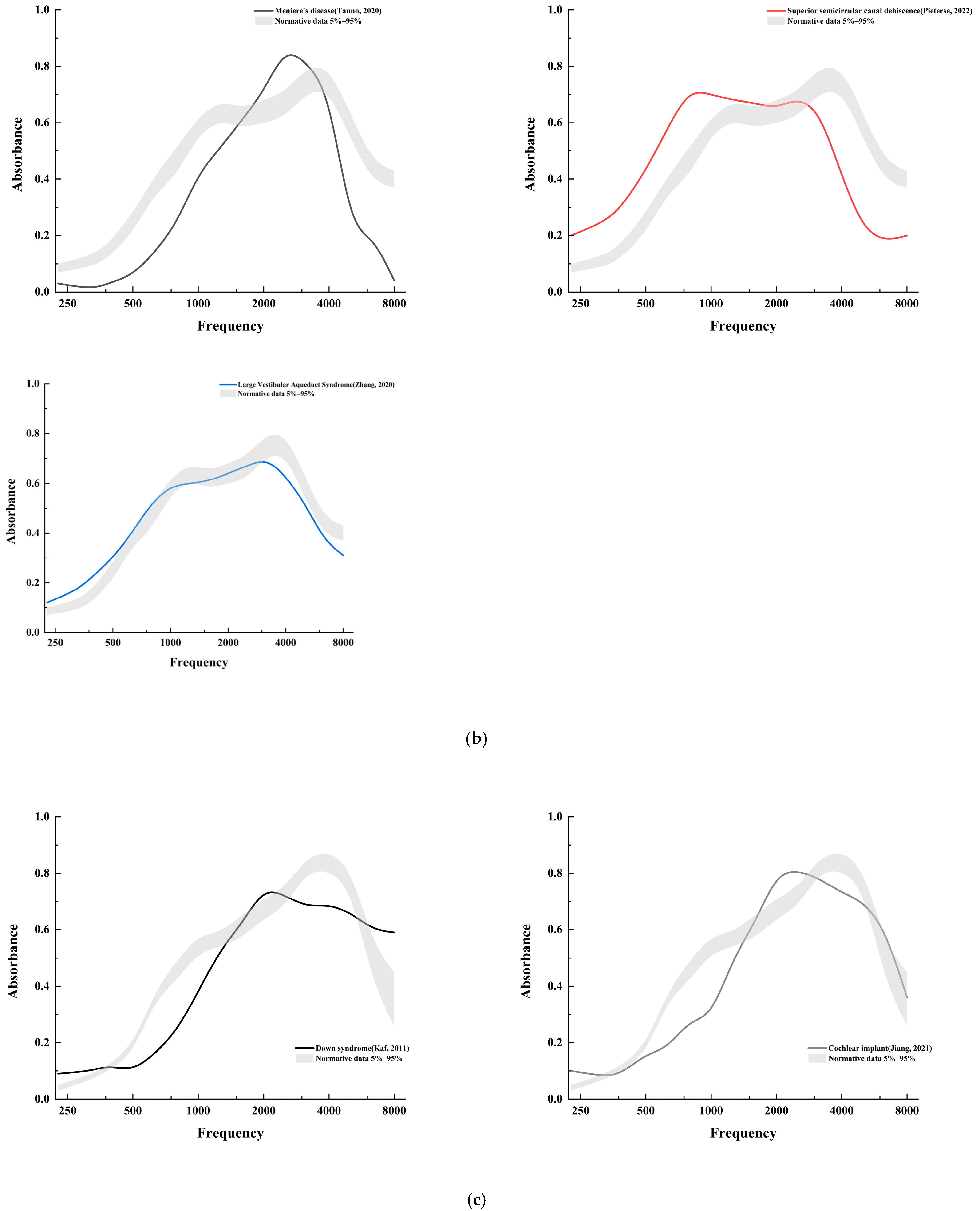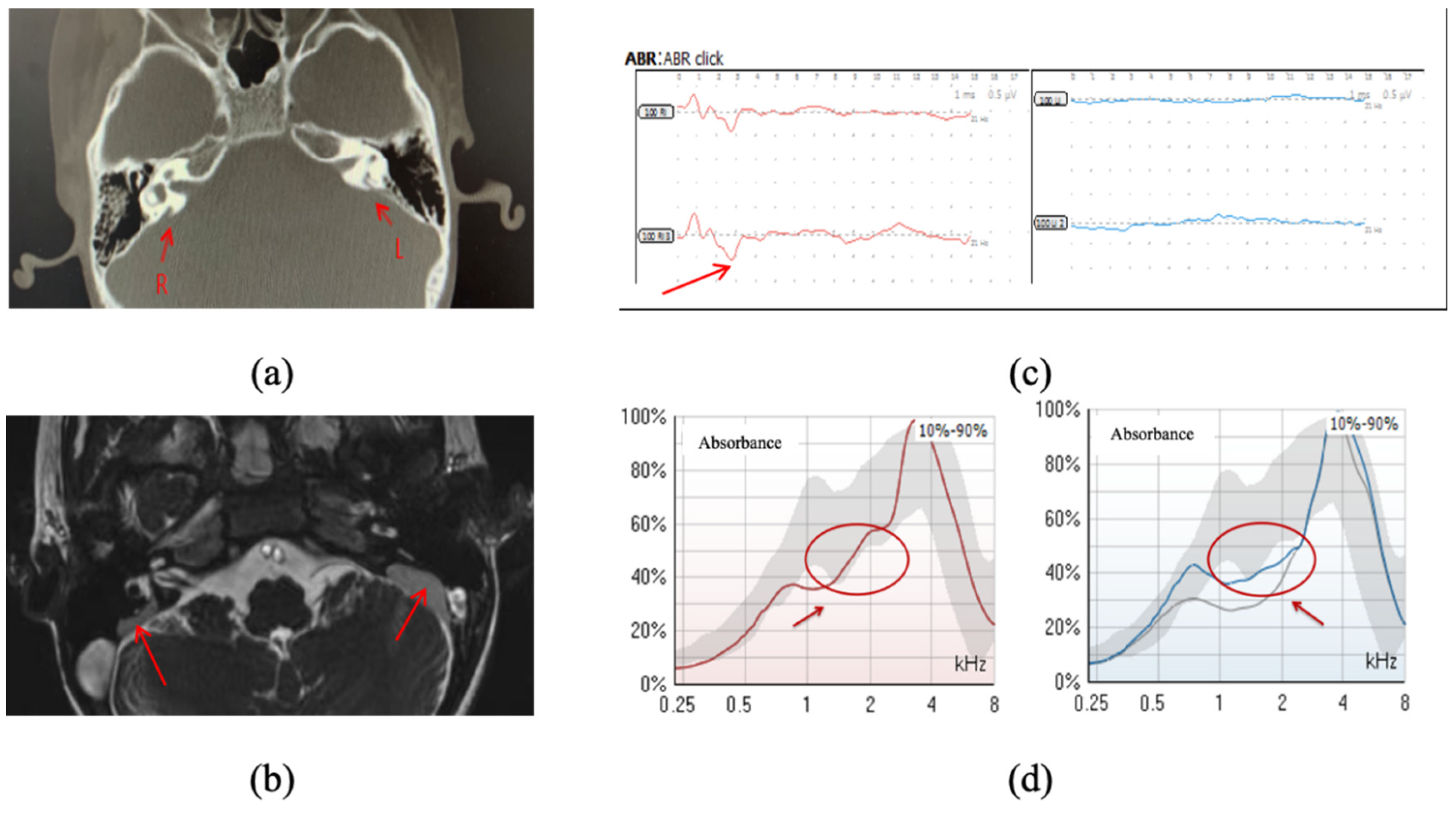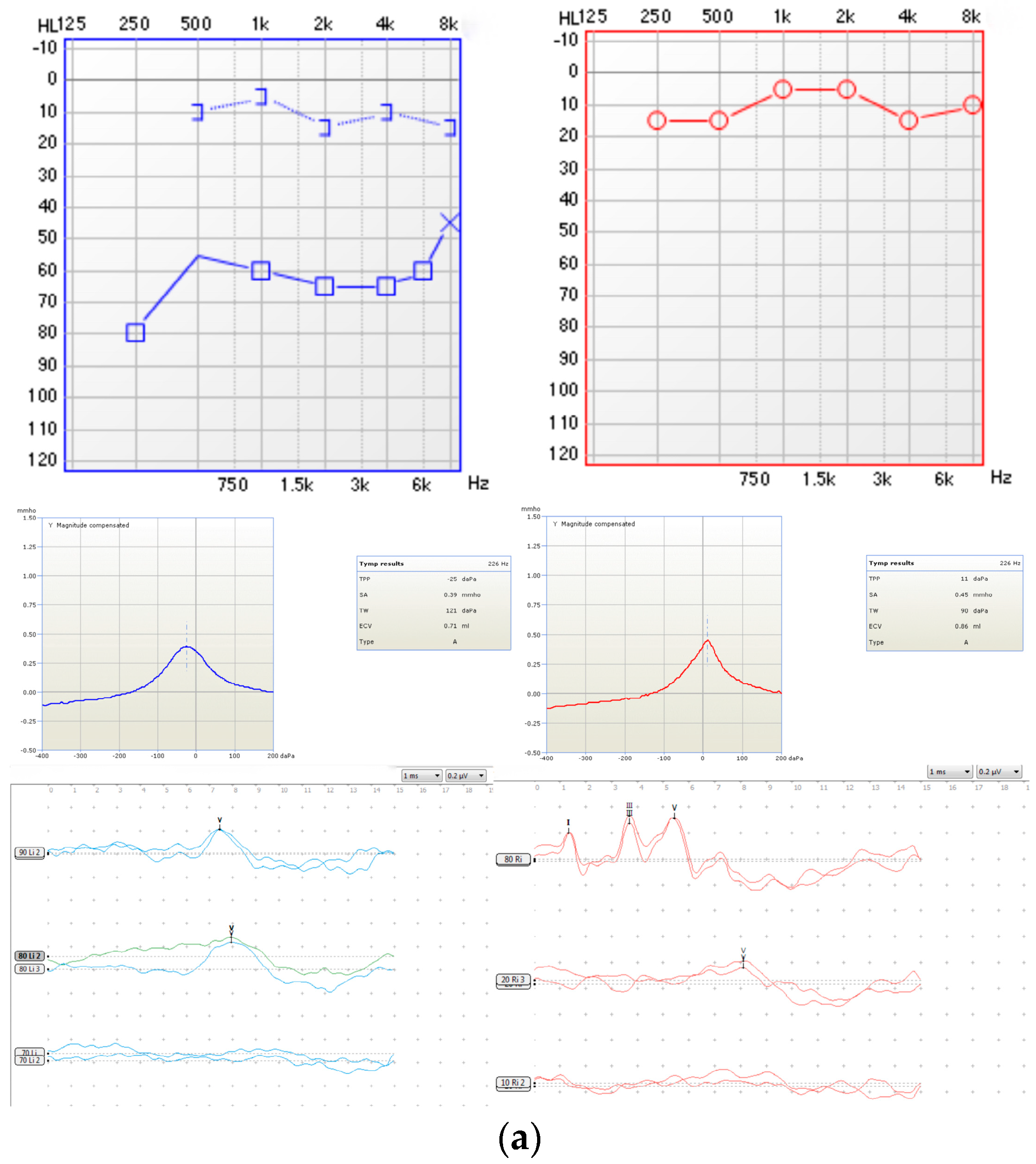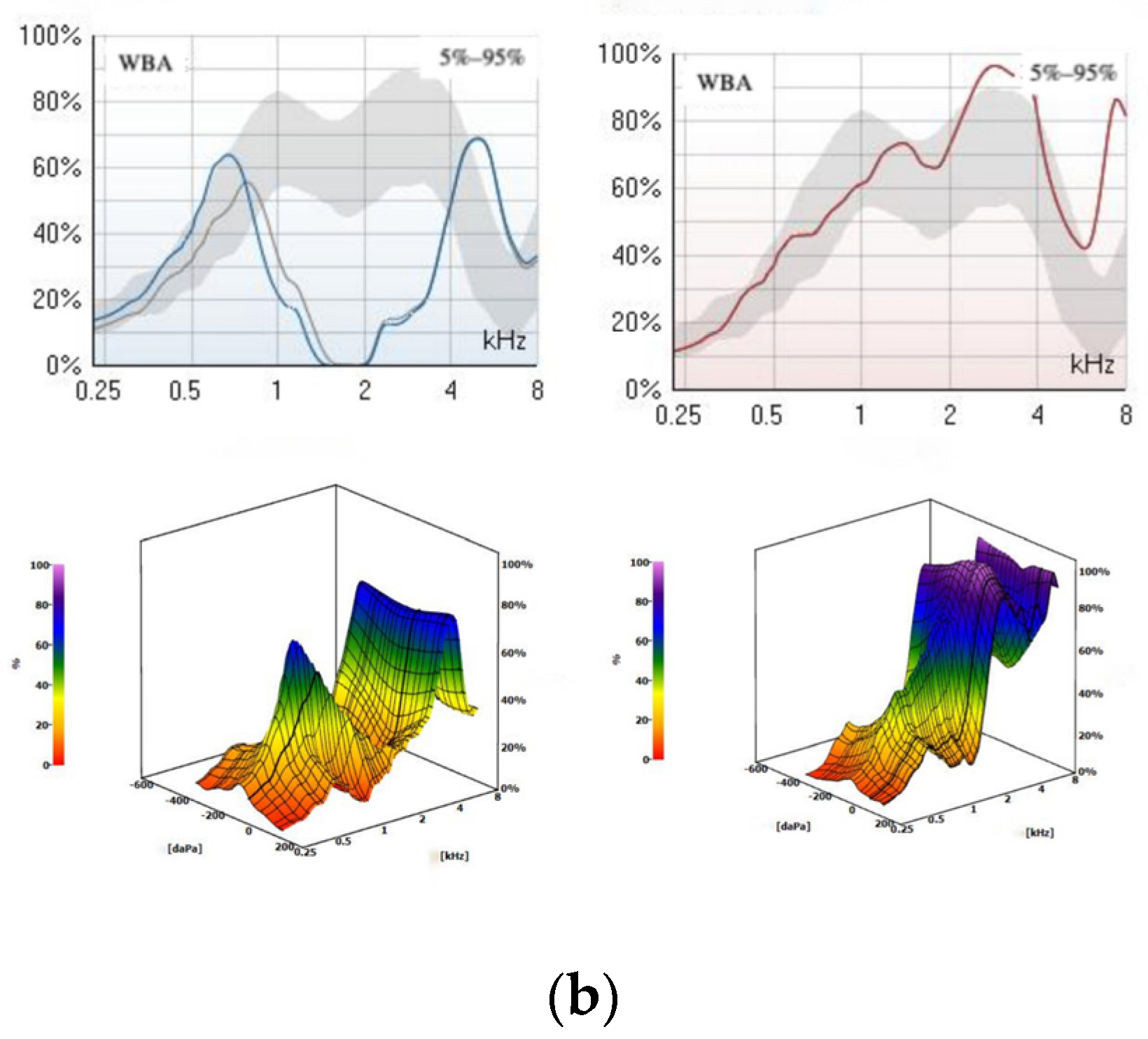Advancements in Pediatric Audiological Assessments Using Wideband Acoustic Immittance: A Review
Abstract
:1. Introduction
2. Establishing Normative Data for Pediatric Wideband Acoustic Immittance
2.1. Comparative Analysis of Wideband Absorbance at Different Ages
2.2. Comparative Analysis of WBA Patterns in Both Children and Adults
2.3. Comparative Analysis of Wideband Absorbance between Ethnicities
3. Characteristics of WAI in Ear Diseases


3.1. Middle-Ear Diseases
3.2. Inner-Ear Diseases
3.3. Other Applications
3.4. Application Summary
| Condition | Author(s) | Study Group (n, age) | Key Findings |
|---|---|---|---|
| Otitis media | Merchant et al. (2023) [51] | 63 ears, 9 months to 11 years 2 months | The analog model produced good fits for all effusion volume (full, partial, or clear) groups, which can estimate behavioral audiometric thresholds within a margin of error that is small enough to be clinically meaningful. |
| Merchant et al. (2021) [37] | 49 ears, 9 months—11 years | A multivariate logistic regression approach was utilized. WBA is a strong and sensitive indicator of OME. | |
| Liang et al. (2021) [52] | 136 ears, 3–7 years | WBA is an effective method of diagnosing OME in children. The frequency band with the most predictive value of WBA for OME is 0.47–1.03 kHz. | |
| Aithal et al. (2020) [53] | 60 ears, 5.5 ± 3.3 years | WBA demonstrated a high test performance comparable to 226-Hz tympanometry. | |
| Zhang et al. (2023) [32] | 56 ears, 5.82 ± 3.04 years vs. 78 ears, 6.56 ± 2.86 years vs. 70 ears, 5.97 ± 2.75 years | A negative correlation was found between the middle-ear resonance frequency and effusion viscosity, as well as the air-bone gap. | |
| Callaham et al. (2021) [33] | 211 ears, mean age: 2.73 years | WBA can differentiate between types of middle-ear effusion (serous, mucoid, or purulent). | |
| Pan and Yang [15] | 342 ears, 2–16 years | WBT’s utility in diagnosing OME was explored. | |
| Keefe et al. (2012) [28] | 35 ears, 3.5–8.2 years | WBA is a more accurate predictor (97–99% accuracy) of OME compared with traditional 226 Hz tympanometry (80–93% accuracy). | |
| Beers et al. (2010) [16] | 64 ears, mean age: 6.34 years | Ethnic differences were found in the energy reflectance and effectiveness of WBA in distinguishing normal ears from those with MEE. | |
| Cochlear implant | Jiang et al. (2021) [34] | 20 ears, 6–8 years | A significantly lower WBA was found in the OME group compared with the control group under different pressure conditions. |
| Wu et al. (2021) [50] | 12 ears, 6–8 years and 2.52 ± 0.51 years | The WBA characteristics in infants with cochlear implants were studied. | |
| Down syndrome | Kaf (2011) [35] | 19 ears, 2½–5 years | The WBR in children with Down syndrome was analyzed, revealing unique patterns. |
| Soares et al. (2016) [48] | 42 ears, 2–16 years | WBR was investigated as a diagnostic tool in children with Down syndrome. | |
| Inner-ear malformations | Kaya et al. (2020) [5] | 107 ears, 3–37 years | The WBA in various inner-ear malformations was examined. |
| Large vestibular aqueduct syndrome | Jiang et al. (2024) [46] | 82 ears, 6 months–11 years | Lower WBA values at 1259–2000 Hz and higher values at 4000–6349 Hz were found. |
| Li et al. (2023) [21] | 38 ears, mean age: 57 months | A higher WBA at low–mid-frequencies (343–1124 Hz and 1943–2448 Hz) was found in the LVAS group compared with the control groups, while it was lower at high frequencies (3886–6727 Hz). | |
| Ding et al. (2021) [47] | 40 ears, 3–11 years | A higher WBA at 226–1000 Hz was found. | |
| Zhang et al. (2020) [30] | 24 ears, 3–9 years | A lower WBA at 1000, 1189, 1296, 2000, and 4000 Hz was found. |
4. Further Clinical Implications with Case Studies
5. Case 1: Bilateral Large Vestibular Aqueduct Syndrome (LVAS)
5.1. Patient Background and Initial Assessment
5.2. WAI Findings
5.3. Clinical Significance

6. Case 2: Cholesteatoma
6.1. Medical History
6.2. Clinical Examination
6.3. WAI Findings
6.4. Surgical Intervention
6.5. Clinical Significance
7. Limitations
8. Future Studies
9. Conclusions
Author Contributions
Funding
Institutional Review Board Statement
Informed Consent Statement
Data Availability Statement
Conflicts of Interest
References
- Rosowski, J.J.; Wilber, L.A. Acoustic Immittance, Absorbance, and Reflectance in the Human Ear Canal. Semin. Hear. 2015, 36, 11–28. [Google Scholar] [CrossRef] [PubMed]
- Tanno, G.A.Y.; Santos, M.A.O.; Sanches, M.T.D.; Durante, A.S.; Almeida, K.; Gameiro, M.S.; Roque, N.; Sousa Neto, O.M. Analysis of wideband tympanometry in Meniere’s disease. Braz. J. Otorhinolaryngol. 2020, 88, 194–203. [Google Scholar] [CrossRef] [PubMed]
- Kei, J.; Zhao, F. Assessing Middle Ear Function in Infants; Plural Publishing: San Diego, CA, USA, 2012. [Google Scholar]
- Aithal, S.; Aithal, V.; Kei, J.; Manuel, A. Effect of Negative Middle Ear Pressure and Compensated Pressure on Wideband Absorbance and Otoacoustic Emissions in Children. J. Speech Lang. Hear. Res. 2019, 62, 3516–3530. [Google Scholar] [CrossRef]
- Kaya, S.; Cicek Cinar, B.; Ozbal Batuk, M.; Ozgen, B.; Sennaroglu, G.; Genc, G.A.; Sennaroglu, L. Wideband tympanometry findings in inner ear malformations. Auris Nasus Larynx 2020, 47, 220–226. [Google Scholar] [CrossRef] [PubMed]
- Demir, E.; Afacan, N.N.; Celiker, M.; Celiker, F.B.; İnecikli, M.F.; Terzi, S.; Dursun, E. Can Wideband Tympanometry Be Used as a Screening Test for Superior Semicircular Canal Dehiscence? Clin. Exp. Otorhinolaryngol. 2019, 12, 249–254. [Google Scholar] [CrossRef] [PubMed]
- Mozaffari, M.; Nash, R.; Tucker, A.S. Anatomy and Development of the Mammalian External Auditory Canal: Implications for Understanding Canal Disease and Deformity. Front. Cell Dev. Biol. 2021, 8, 617354. [Google Scholar] [CrossRef] [PubMed]
- Campos Ude, P.; Hatzopoulos, S.; Śliwa, L.K.; Skarżyński, P.H.; Jędrzejczak, W.W.; Skarżyński, H.; Carvallo, R.M. Relationship Between Distortion Product—Otoacoustic Emissions (DPOAEs) and High-Frequency Acoustic Immittance Measures. Med. Sci. Monit. 2016, 22, 2028–2034. [Google Scholar] [CrossRef] [PubMed]
- Sanford, C.A.; Keefe, D.H.; Liu, Y.W.; Fitzpatrick, D.; McCreery, R.W.; Lewis, D.E.; Gorga, M.P. Sound-conduction effects on distortion-product otoacoustic emission screening outcomes in newborn infants: Test performance of wideband acoustic transfer functions and 1-kHz tympanometry. Ear Hear. 2009, 30, 635–652. [Google Scholar] [CrossRef] [PubMed]
- Hearing, J.C.o.I. Year 2007 position statement: Principles and guidelines for early hearing detection and intervention programs. Pediatrics 2007, 120, 898–921. [Google Scholar]
- Cain, S.E.; Gomes, T.; Leisner, D.; Lenzen, N.; Rall, E.; Schicke, E.; Uhler, K.M. Assessment of Hearing in Infants and Young Children: Clinical Guidance Document; American Academy of Audiology: Reston, VA, USA, 2020; Available online: https://www.audiology.org/wp-content/uploads/2021/05/Clin-Guid-Doc_Assess_Hear_Infants_Children_1.23.20.pdf (accessed on 1 August 2024).
- Lin, D.; Lin, S.; Lin, Y.; Shu, B.; Hu, J.; Ye, S. Characteristics of Wideband Acoustic Immittance (WAI) Energy Absorption Rate in Infants and Young ChiIdren and AnaIysis of ReIated Factors. J. Audiol. Speech Pathol. 2022, 30, 523–527. [Google Scholar]
- Peng, S.; Li, G.; Yin, H.L.; Yao, X.Y. A preliminary study on wideband acoustic immittance of infants with normal bilateral middle ear function at the age of 1–5 months. J. Clin. Otorhinolaryngol. Head. Neck Surg. 2023, 37, 231–234. [Google Scholar]
- Stuppert, L.; Nospes, S.; Bohnert, A.; Läßig, A.K.; Limberger, A.; Rader, T. Clinical benefit of wideband-tympanometry: A pediatric audiology clinical study. Eur. Arch. Otorhinolaryngol. 2019, 276, 2433–2439. [Google Scholar] [CrossRef] [PubMed]
- Pan, J.; Yang, J. The clinical value of wideband tympanometry in the diagnosis of otitis media with effusion. J. Clin. Otorhinolaryngol. Head. Neck Surg. 2018, 32, 1309–1315. [Google Scholar]
- Beers, A.N.; Shahnaz, N.; Westerberg, B.D.; Kozak, F.K. Wideband reflectance in normal Caucasian and Chinese school-aged children and in children with otitis media with effusion. Ear Hear. 2010, 31, 221–233. [Google Scholar] [CrossRef] [PubMed]
- Shahnaz, N.; Aithal, S.; Bargen, G.A. Wideband Acoustic Immittance in Children. Semin. Hear. 2023, 44, 46–64. [Google Scholar] [CrossRef] [PubMed]
- Guo, Q.; Yao, H.; Sun, X.; Zhuang, R.; Zou, B. Study of the Wideband Absorbance in Chinese Pre-school Children with Normal Hearing. J. Audiol. Speech Pathol. 2021, 29, 373–377. [Google Scholar] [CrossRef]
- Durante, A.S.; Santos, M.; Roque, N.; Gameiro, M.S.; Almeida, K.; Sousa Neto, O.M. Wideband acoustic absorbance in children with Down syndrome. Braz. J. Otorhinolaryngol. 2019, 85, 193–198. [Google Scholar] [CrossRef] [PubMed]
- Sunil, L.K.; Perry, J.; Hudson, S. Racial Variations in Velopharyngeal and Craniometric Morphology in Children: An Imaging Study. J. Speech Lang. Hear. Res. 2016, 59, 27–38. [Google Scholar]
- Li, A.; Du, H.; Gao, J.; Xu, Y.; Zhao, N.; Gao, S.; Xing, Y.; Qian, X.; Gao, X.; Yang, Y. Characteristics of large vestibular aqueduct syndrome in wideband acoustic immittance. Front. Neurosci. 2023, 17, 1185033. [Google Scholar] [CrossRef] [PubMed]
- Lv, S. Age, Gender and Middle Ear Effusion Effects on Wideband Energy Reflectance. Master’s Thesis, Zhengzhou University, Zhengzhou, China, 2018. [Google Scholar]
- Sun, J.; Fu, Y.; Xu, B.; Bi, J.; Liu, J. Application of Wideband Tympanometry to Middle Ear Function Evaluation in Infants Aged 0–24 Months. Chin. J. Otol. 2021, 19, 258–264. [Google Scholar]
- Xing, Y.; Jiang, W.; Tong, Y.; Wu, Y.; Liu, W.; Qiao, Y. A preliminary study on the energy absorbance of wideband acoustic immittance in young adults with normal hearing. J. Otolaryngol. Ophthalmol. Shandong Univ. 2020, 34, 38–41. [Google Scholar] [CrossRef]
- Zhao, Z.; Lin, Y.; Ren, C.; Li, L.; Fan, X.; Guo, Q.; Zha, D. Characteristics of Wideband Acoustic Immittance in Patients with Secretory Otitis Media. J. Audiol. Speech Pathol. 2021, 29, 635–638. [Google Scholar]
- Karuppannan, A.; Barman, A. Wideband absorbance tympanometry: A novel method in identifying otosclerosis. Eur. Arch. Oto-Rhino-Laryngol. 2021, 278, 4305–4314. [Google Scholar] [CrossRef] [PubMed]
- Wang, X.; Su, W.; Luo, X. The diagnosticvalueof wideband acousticimmittancein otosclerosisand congenital auditoIy bone chain deformity. Chin. Arch. Otolaryngol.-Head Neck Surg. 2023, 30, 10–12. [Google Scholar]
- Keefe, D.H.; Sanford, C.A.; Ellison, J.C.; Fitzpatrick, D.F.; Gorga, M.P. Wideband aural acoustic absorbance predicts conductive hearing loss in children. Int. J. Audiol. 2012, 51, 880–891. [Google Scholar] [CrossRef] [PubMed]
- Pieterse, H.; Biagio-De Jager, L.; Hofmeyr, L.M.; Vinck, B. Wideband acoustic immittance in superior semicircular canal dehiscence. Auris Nasus Larynx 2022, 49, 921–927. [Google Scholar] [CrossRef] [PubMed]
- Zhang, L.; Wang, J.; Zhao, F.; Li, Y. Inner ear pressure evaluation using wideband tympanometry in children with Large Vestibular Aqueduct Syndrome (LVAS): A pilot study. Int. J. Pediatr. Otorhinolaryngol. 2020, 128, 109690. [Google Scholar] [CrossRef] [PubMed]
- Sato, E.; Nakashima, T.; Lilly, D.J.; Fausti, S.A.; Ueda, H.; Misawa, H.; Uchida, Y.; Furuhashi, A.; Asahi, K.; Naganawa, S. Tympanometric findings in patients with enlarged vestibular aqueducts. Laryngoscope 2002, 112, 1642–1646. [Google Scholar] [CrossRef] [PubMed]
- Zhang, X.; Tian, M.; Zhang, L. Correlation analysis of Wideband Acoustic Immittance with middle ear effusion viscosity and air bone conduction difference in children with otitis media. J. Med. Theory Pract. 2023, 36, 1932–1934. [Google Scholar]
- Callaham, S.; Newby, M.; Saoji, A.A.; Ramadan, J.; Carr, M.M. Assessment of pediatric middle ear effusions with wideband tympanometry. Otolaryngol. Head Neck Surg. 2021, 165, 465–469. [Google Scholar] [CrossRef] [PubMed]
- Jiang, W.; Huang, N.; Tian, C. Acoustic Absorbance Characteristics of Wideband Tympanometry in Children with Unilateral Cochlear Implant. J. Audiol. Speech Pathol. 2021, 29, 369–372. [Google Scholar]
- Kaf, W.A. Wideband energy reflectance findings in presence of normal tympanogram in children with Down’s syndrome. Int. J. Pediatr. Otorhinolaryngol. 2011, 75, 219–226. [Google Scholar] [CrossRef] [PubMed]
- Shahnaz, N.; Feeney Mp Fau—Schairer, K.S.; Schairer, K.S. Wideband acoustic immittance normative data: Ethnicity, gender, aging, and instrumentation. Ear Hear. 2013, 34, 27s–35s. [Google Scholar] [CrossRef] [PubMed]
- Merchant, G.R.; Al-Salim, S.; Tempero, R.M.; Fitzpatrick, D.; Neely, S.T. Improving the Differential Diagnosis of Otitis Media With Effusion Using Wideband Acoustic Immittance. Ear Hear 2021, 42, 1183–1194. [Google Scholar] [CrossRef] [PubMed]
- Sheng, H.; Zhou, Q.; Li, H.; Ren, Y.; Han, K.; Huang, M.; Chen, Y.; Li, Q.; Li, W.; Huang, Z. Characteristics and clinical significance of wideband tympanometry of otitis media with effusion in young children. Chin. J. Otorhinolaryngol. Head Neck Surg. 2021, 56, 579–585. [Google Scholar]
- Gao, M.; Yin, D.; Fan, M.; Dou, X. Eigenvalue analysis of wideband acoustic immittance in secretory otitis media in children of different ages. J. Clin. Otorhinolaryngol. Head Neck Surg. 2022, 36, 180–184. [Google Scholar]
- Miehe, J.; Mogensen, S.; Lyhne, N.; Skals, R.; Hougaard, D.D. Wideband tympanometry as a diagnostic tool for Meniere’s disease: A retrospective case-control study. Eur. Arch. Oto-Rhino-Laryngol. 2022, 279, 1831–1841. [Google Scholar] [CrossRef] [PubMed]
- Riggs, W.; Hiss, M.; Varadarajan, V.; Mattingly, J.; Adunka, O. Enlarged vestibular aqueduct: Intraoperative electrocochleography findings during cochlear implantation. Int. J. Pediatr. Otorhinolaryngol. 2020, 134, 110065. [Google Scholar] [CrossRef] [PubMed]
- Valvassori, G.E.; Clemis, J.D. The large vestibular aqueduct syndrome. Laryngoscope 1978, 88, 723–728. [Google Scholar] [CrossRef] [PubMed]
- Madden, C.; Halsted, M.; Benton, C.; Greinwald, J.; Choo, D. Enlarged vestibular aqueduct syndrome in the pediatric population. Otol. Neurotol. 2003, 24, 625–632. [Google Scholar] [CrossRef] [PubMed]
- Noguchi, Y.; Fukuda, S.; Fukushima, K.; Gyo, K.; Hara, A.; Nakashima, T.; Ogawa, K.; Okamoto, M.; Sato, H.; Usami, S.I.; et al. A nationwide study on enlargement of the vestibular aqueduct in Japan. Auris Nasus Larynx 2017, 44, 33–39. [Google Scholar] [CrossRef] [PubMed]
- Hura, N.; Stewart, M.; Walsh, J. Progression of hearing loss and cochlear implantation in large vestibular aqueduct syndrome. Int. J. Pediatr. Otorhinolaryngol. 2020, 135, 110133. [Google Scholar] [CrossRef] [PubMed]
- Jiang, W.; Li, X.; Mu, Y.; Zhang, H.; Konduru, N.; Qiao, Y.; Zhao, F.; Liu, W. Predictive accuracy of wideband absorbance in children with large vestibular aqueduct syndrome: A single-center retrospective study. Heliyon 2024, 10, E33776. [Google Scholar] [CrossRef] [PubMed]
- Ding, L.; Wang, C.; Shi, W. A Preliminary Study on Characteristics of Tympanic Membrane Absorbance in Patients with Large Vestibular Aqueduct Syndrome. Chin. J. Otol. 2021, 19, 16–20. [Google Scholar]
- Soares, J.C.; Urosas, J.G.; Calarga, K.S.; Pichelli, T.S.; Limongi, S.C.; Shahnaz, N.; Carvallo, R.M. Wideband reflectance in Down syndrome. Int. J. Pediatr. Otorhinolaryngol. 2016, 87, 164–171. [Google Scholar] [CrossRef] [PubMed]
- Merchant, G.R.; Schulz, K.M.; Patterson, J.N.; Fitzpatrick, D.; Janky, K.L. Effect of Cochlear Implantation on Vestibular Evoked Myogenic Potentials and Wideband Acoustic Immittance. Ear Hear 2020, 41, 1111–1124. [Google Scholar] [CrossRef] [PubMed]
- Wu, S.; Guan, R.; Wang, Y.; Zhang, B.; Li, P.; Shen, F.; Sun, J.; Sun, J. The Characteristics of Wideband Absorbance (WBA) in Infants with Cochlear Implant. J. Audiol. Speech Pathol. 2021, 29, 361–364. [Google Scholar]
- Merchant, G.R.; Neely, S.T. Conductive Hearing Loss Estimated from Wideband Acoustic Immittance Measurements in Ears With Otitis Media With Effusion. Ear Hear. 2023, 44, 721–731. [Google Scholar] [CrossRef]
- Liang, J.; Xiao, L.; Sun, X.Y.; Zou, B. Characteristics of the wideband absorbance of acoustic energy in children (3–7 years old) with otitis media with effusion. Int. J. Pediatr. Otorhinolaryngol. 2021, 140, 110496. [Google Scholar] [CrossRef] [PubMed]
- Aithal, V.; Aithal, S.; Kei, J.; Anderson, S.; Wright, D. Predictive Accuracy of Wideband Absorbance at Ambient and Tympanometric Peak Pressure Conditions in Identifying Children with Surgically Confirmed Otitis Media with Effusion. J. Am. Acad. Audiol. 2020, 31, 471–484. [Google Scholar] [CrossRef]
- Emara, A.A. Acoustically evoked, short latency negative response in children with sensorineural hearing loss. J. Laryngol. Otol. 2010, 124, 141–146. [Google Scholar] [CrossRef] [PubMed]
- Nong, D.X.; Ura M Fau-Kyuna, A.; Kyuna A Fau-Owa, T.; Owa T Fau-Noda, Y.; Noda, Y. Saccular origin of acoustically evoked short latency negative response. Otol. Neurotol. 2002, 23, 953–957. [Google Scholar] [CrossRef] [PubMed]


Disclaimer/Publisher’s Note: The statements, opinions and data contained in all publications are solely those of the individual author(s) and contributor(s) and not of MDPI and/or the editor(s). MDPI and/or the editor(s) disclaim responsibility for any injury to people or property resulting from any ideas, methods, instructions or products referred to in the content. |
© 2024 by the authors. Licensee MDPI, Basel, Switzerland. This article is an open access article distributed under the terms and conditions of the Creative Commons Attribution (CC BY) license (https://creativecommons.org/licenses/by/4.0/).
Share and Cite
Jiang, W.; Mu, Y.; Zhao, F.; Wang, P. Advancements in Pediatric Audiological Assessments Using Wideband Acoustic Immittance: A Review. Audiol. Res. 2024, 14, 684-700. https://doi.org/10.3390/audiolres14040058
Jiang W, Mu Y, Zhao F, Wang P. Advancements in Pediatric Audiological Assessments Using Wideband Acoustic Immittance: A Review. Audiology Research. 2024; 14(4):684-700. https://doi.org/10.3390/audiolres14040058
Chicago/Turabian StyleJiang, Wen, Yi Mu, Fei Zhao, and Peng Wang. 2024. "Advancements in Pediatric Audiological Assessments Using Wideband Acoustic Immittance: A Review" Audiology Research 14, no. 4: 684-700. https://doi.org/10.3390/audiolres14040058







